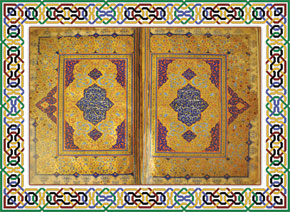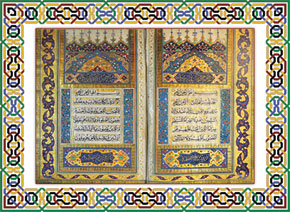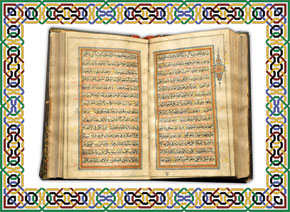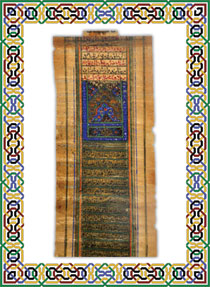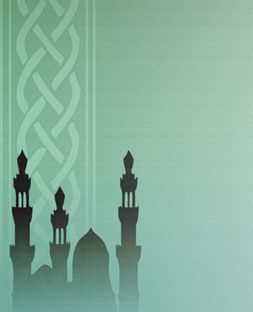 Pages 32-36
Pages 32-36Naila Suleymanova
There have been many developments in culture and theology since the Qur’an was revealed to Prophet Muhammad. Trends in Islamic culture, have been developed, learnt and taught by Muslims over the centuries since then. One notable example is the art of handwriting books. After Prophet Muhammad’s death, his followers wrote descriptions of his life, his theological views and hadiths (sayings and deeds) and about the wars he took part in. Subsequent works on the history of Islam, theology and hadith studies have been written by Muslim scholars who based their research on information given by the followers. Multiple rewriting of these works resulted in the emergence of handwritten books in Islamic culture.
140 Handwritten Copies of the Qur’an
Islam refocused social, cultural and political life in Azerbaijan. The oldest copies of handwritten books preserved in Azerbaijan to the present, date back to the 9th century. [9] Their writing style and general design indicates that the art has been in continuous development in Azerbaijan and the collection is highly valued for the content, number and artistic design of the books. [7, 56] Resources say that in the Middle Ages (12th century) the Maragha madrasah (school) alone had 400,000 handwritten books of various artistic design and content. [1, 7] Copies of works written by Azerbaijani scientists in the fields of medicine, philosophy, literature, astronomy, mathematics, logic and Islamic theology, have survived to the present day and are preserved in the museums and libraries of Istanbul, London, the Vatican, New York, Dresden, Paris, Mostar, Bratislava, Sarajevo and other cities. From the 13th century to the early 20th century, the works of Nizami Gajnavi, Nasraddin Tusi and Afzaladdin Abhari were among the most widely copied books in countries like Turkey, Iran, Iraq, Central Asia and India.
After the arrival of Islam, the most commonly read book in Azerbaijan until the start of the 20th century was the Qur’an and its interpretations. According to information given by Arab historian El Belazuri, when Al Ashas ibn Gheys was appointed by the Caliph Ali ibn Abu Talib (644 – 656) to rule over Azerbaijan, it was stated:
When he came to Azerbaijan he saw that the majority of the Azerbaijani population had already converted to Islam and read the Qur’an. [2, 50]
Copies of the Qur’an, produced in Azerbaijan over the centuries, besides being among the best examples of handwritten books, are also valuable artistic monuments to their times. These books, each taking 3 to 10 years to produce, were among the most valuable gifts sent by monarchs, shahs, emirs and other rulers to each other. There are currently 140 volumes of handwritten Qur’an books of various sizes and artistic design held in the Academy of Science’s Institute of Manuscripts. One of these valuable documents is a handwritten copy of the sura Al Galam, written on parchment.
On making a handwritten book
The members of various crafts were employed to produce a book by hand and embellish it with artistic design. One of these crafts was calligraphy, which demands skill, talent and education. Calligraphers did not simply fill blank pages with writing, they were also involved in editing the works. Artistic and technical development resulted in the emergence of various styles of Arabic script. The first script to emerge was the kufic style – straight lines and angles, with elongated horizontal lines. Other styles followed: naskh, nastaliq, shikastah, sulus, reyhani and ruqa. Of Azerbaijani calligraphers Mirali Tabrizli (14th century) used the nastaliq script and Murtuzgulu khan Shamlu (17th century) wrote in the shikastah script. Calligraphy in Arabic script emerged only with the copying by hand of the Qur’an, which is also thought to be the first written work of Islam. Another art employed in creating these books is tazhib (illumination), to produce decorations in star and floral motifs, using gilded ink and other colours. First used by the Uyghur Turks in Asia, it quickly became an art widely practised among other Turkic nations. [11, 487] The artistic decoration of handwritten books also called upon craftsmen to prepare the all-important cover. Classical covers were made from leather, front and back, sometimes with an extension on the back cover, called a miglab, which could be folded up to ‘close’ the book . Later, leather covers were gradually replaced by cardboard, paper and, eventually, plastic materials. [10]
One may observe examples of all three crafts in copies of handwritten Qur’an books preserved in Azerbaijan. Writing the Qur’an was the most popular and treasured work for calligraphers of the Muslim world. Among them there have been some who have written out up to five hundred copies of the Qur’an, and others who managed only one or two. Completed copies were laboriously checked by comparing them with the original. The new ones were then taken to the tazhib masters. Once their work was done, the books were covered.
Azerbaijani Copies of the Qur’an
M-142 (size 20 x 30.5; volume of 530 sheets) – In this handwritten copy of the Qur’an the first two, white, pages are inscribed in black ink in nastaliq style, and devoted to the sura Fatiha. These two pages and the pages of the first five verses of the sura Baqarah were illuminated by a tazhib master using gilded ink. All the pages are framed in gold and dark blue. Translations into Persian are written under the original text, using a smaller font in red and in shikastah style. The pages have juz flowers to mark the beginning of each of the thirty sections of the Qur’an, called juz. Hizb flowers mark the beginning of each quarter (hizb) of the juz. Each mark has a number in Arabic, noting the sequence of juzs and hizbs. The text is framed by a red-coloured, floral motif tazhib. In this copy of the Qur’an each sura has information about its title, where it was received, and the number of verses, decorated with very elegant motifs. The calligrapher used red ink for the title of the sura. To mark the bow verses (ie. where the pray-er should bow) he used other floral tazhibs. The word ‘bow’ is enclosed in the floral tazhib.
The words In the name of Allah, the most beneficent, the most merciful at the head of each sura are elegantly decorated with tazhibs in gold and red. There are marks called vagf at the end of each verse or expression. Those vagfs are decorated with floral tazhibs, in gold and red. The cover is from Isfahan. It is decorated with a selvedge and ornaments. This copy of the Qur’an, reproduced in 1271 by the Hijra calendar, with a high level craftsmanship, was produced to order.
…We have finished this Qur’an. …It has been written to order from Navvab Abbas Mirza. The book is from Shiraz, Allah’s blessings be upon it.
M-257 (size 19 x 30; volume of 305 sheets) - belonged to the famous Azerbaijani poetess Khurshidbanu Natavan. The book was written in the 19th century in black ink and naskh style script by Muhammad Ali Muhammad Shafi Tabrizi. The first and second pages are decorated with floral motif tazhibs in blue, deep red, and gold. Pages are framed in gold and red colours. The text is underlined in gold. The information about the suras, where they were received and the number of verses, at the beginning of each sura, is framed in gold. The starting points of juzs are marked with gold-coloured, floral motif tazhibs. The vagf signs are written in red ink. It has a cardboard cover and is framed in the middle. The centre of the frame is decorated with floral motif tazhibs in gold, deep red, and green. There are examples of Qur’an verses on the outer part of the frame. The cover is lacquered, a technique which preserved vividness of colour. There is no doubt that this copy of the Qur’an was also prepared to order. The calligrapher’s pseudonym reveals that it was produced in Tabriz.
D-574 (size 24 x 30; volume of 491 sheets) - was written on white sheet in black ink and excellent nastaliq style, in 1146 by the Hijra calendar (1690 AD). The first and last pages are illuminated with geometrical and floral motif tazhibs using the colours gold, red and blue. All the pages are framed in gold colour. Translations of the verses into Persian under the text are written in a smaller font, in shikastah style and in red ink. The text is underlined in gold. The information about the suras, where they were received, and the number of verses, at the beginning of each sura, is framed in gold and partly illuminated by tazhibs. The juzs numbers are written in gold in the corner, at the top of the pages. The craftsman who prepared the cover used leather and decorated it with a sun-like motif called shamsa, with flowers drawn inside. Calligraphers usually gave information about their name and place of origin, as well as information about the dates and places where the texts were written, at the end of a handwritten text. These artists of gentle spirit named themselves with expressions like Al Faghir (in need of God), Al Haghir (worthless next to the greatness of God), and Al Muznib (sinful). In this copy of the Qur’an, the calligrapher has also named himself Al Faghir, Al Haghir Abd bin Bangazur bin Firuz.
D-192 (size 23 x 33; volume of 640 sheets) - was written in a very beautiful and accurate nastaliq style, in black ink, in Sarab in 903 by the Hijra calendar (1497 AD). The first two pages are decorated with tazhibs in gold. All the pages are framed by two colours – gold and red. The information about suras at the beginning of each sura, is decorated with tazhibs in delicate golden motifs. The calligrapher used red ink for the titles of each sura. Floral tazhibs mark the juzs, hizbs, and vagfs. Translations into Persian are given under each verse in red ink, using a smaller font and shikastah script. The calligrapher in this case was Abdul Hagg Muhammad. There is a cardboard cover which has a miglab (a fold-up extension of the back cover). Both the upper and the miglab part of the cover are decorated with images of flowers, painted in gold. The elegance and integrity of the copy indicate that was prepared to order.
A-898 (size 9 x 14; volume of 256 sheets) - was written in black ink in nastaliq style with elements of shikastah. Every page is decorated with tazhibs in gold and red. The craftsman has used motifs called barg (i.e. motifs in the form of green leaves) more often than any other in his tazhibs. The ‘mad’ diacritics (to prolong the sound of a letter) are marked in the text in red ink. The information about suras and juz, hizb, and vagfs is indicated by floral motif tazhibs in gold. The cover is engraved with a shamsa (sun-like motif). Some calligraphers preferred not to leave any information about themselves, considering modesty a most worthy attribute. So there is no information about the calligrapher who wrote this copy of the Qur’an.
A-910 (size 10 x 12; volume of 508 sheets) - was written in a distinct and beautiful naskh style in black ink. Despite its small size, the text is accurate and clearly legible. Every page is framed in gold. The craftsman used blue and gold for the tazhibs when decorating the copy. The information about suras, at the beginning of each sura, is framed in gold. The number of the juz is encircled in gold. Hizbs and bow lines are written on the side in black ink, with no tazhibs. Vagfs are in red ink. The cover was made from cardboard and illuminated on both sides with floral motif tazhibs. Further, bouquets of white flowers are depicted inside the cover, on both sides. There is no information about who wrote this copy.
B-3710 (size 25 x 32; volume of 307 sheets) - was written in an accurate naskh style in 1275 (1858 AD). In contrast to other copies, the rules of tajwid (which govern how the Qur’an should be read) are clearly set out. Information about the seven imams and their ravis (persons who retell hadiths) is given in the form of a table before the main text. Every page is framed in gold and blue. There are juz flowers on the sides of pages to mark the starting points, hizb flowers mark the beginnings of hizbs, and flower marks show the bow lines. In all three cases information on juzs, hizbs, and bow lines is written inside the flowers. Information about suras is given at the beginning of each sura, depicted in gold. The cover is cardboard and decorated with floral motif tazhibs. The calligrapher acknowledges himself by writing his name The Calligrapher Jamaladdin on the last page.
D-101 (size 20 x 30; volume of 286 sheets) - was written with black ink in sulus style in 1203 (1788 AD). The first two pages are embellished with delicate tracery and rich ornamentation. Translations into Persian are written under the original text, using a smaller font and in red. Every page is framed in gold and blue. Juz flowers on the sides of pages mark juzs starting points, hizb flowers mark the beginning of hizbs, and flower marks show the bow lines. The information about suras is illuminated by tazhibs. The cover is cardboard and decorated with framed floral motif tazhibs. Information given at the end of the copy acknowledges that it was written in the Shirvan region of Azerbaijan by Abdu’r-Rahim Shirvani.
S-594 (size 20.5 x 30; volume of 140 sheets) - was written in nastaliq style with elements of shikastah in the 11th century (17th century AD). Every page is framed in gold. It also has framed suras in different places on each page. The information about suras is given at the beginning of each sura and decorated in red. Juz flowers on the sides of pages mark juzs starting points, hizb flowers to mark the beginning of hizbs, and flower marks show the bow lines. Vagfs are indicated in red, while lines between the verses are drawn in green. It has a cardboard cover decorated with delicate tracery. This copy is thought to have been prepared to order. The craftsmen declined to sign it.
These copies of the Qur’an are a valuable source for studying the art of the handwritten book and of tasteful artistic design in general. These handwritten Qur’ans, spiritual symbols of the Azerbaijani nation, are of great significance for the study of our cultural heritage.
Sources
1. Treasury of Manuscripts. Journal of the Institute of Manuscripts of ANAS, volume 8. Baku, 1987
2. Mammadov K. Religion and State. December 2008
3. Mammadov Z. History of Azerbaijani Philosophy. Baku, 2006
4. Nuraliyeva T. Catalogue of the Manuscript Collection. Baku, 2006
5. Nuraliyeva T. Catalogue of Manuscripts Endowed. Volume 1. Baku, 2009
6. The Book Culture of Azerbaijan in the Middle Ages. Book album. Baku, 1991
7. Rasim Afandi. The Art of Azerbaijan. Baku, 2007
8. Sharifli K. Handwritten books and libraries of Azerbaijan. Baku, 2009
9. Sharifli K. Fundamentals of textual criticism. Baku, 2003
10. Ozender H. A Glossary of Scripts and Tazhibs. Konya, 2003
11. Ihsanoğlu E. The History of Osmanli Culture. Two volumes. Istanbul, 1999
About the author: Naila Suleymanova works in the Fuzuli Institute of Manuscripts, Azerbaijan National Academy of Sciences. She has a PhD in theology and is an associate professor. The author of two books and a scientific article. She has participated in two international programmes (USA) and in nearly thirty international conferences. Received a grant from the US Department of State in 2010 for translating the book American Muslims.
